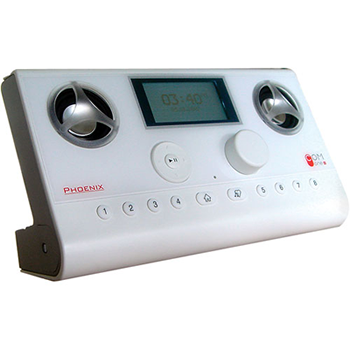Author: Lee Schlesinger
Com One’s Phoenix Wi-Fi radio is a home music appliance built on an embedded Linux foundation. Phoenix lets you stream music or play podcasts as easily as you can listen to a car radio, once you tell it what you want to hear. Its ability to play Internet radio is nice — but is it worth its price?
The radio is attractive enough in a shiny white plastic kind of way. It’s smaller than a boom box — about the size of three transistor radios (remember them?) side by side. The main controls include a five-way circular control pad and a knob that changes the music volume and moves through device settings during setup.
I was eager to test Phoenix, but when I followed the Quick Start Guide’s instructions for automatic network connection, the device said it couldn’t connect to my Wi-Fi access point. A look at my router’s device table showed that it had indeed connected, but the router was unable to ping it. By using the manual connection process — entering an IP address, subnet mask, and DNS server — I was able to make the link. The radio then downloaded and updated a default list of available Internet stations.
Before I got connected, I could set the device’s time manually, but not the date, and the time wouldn’t stay set — the unit added several seconds every minute. Once I was connected, the time and date were set correctly and remained so.
 Phoenix gives you a huge list of stations to choose from. You probably won’t be interested in 99% of them, but you can customize the offerings so that only stations you like are available. To remove or add stations from those available on the unit, log on to the Phoenix site and enter the MAC address of your radio. You can then winnow down the hierarchical list of online radio sources and add your own. The online configuration interface, which is still in beta, is tiresome, involving a lot of clicking.
Phoenix gives you a huge list of stations to choose from. You probably won’t be interested in 99% of them, but you can customize the offerings so that only stations you like are available. To remove or add stations from those available on the unit, log on to the Phoenix site and enter the MAC address of your radio. You can then winnow down the hierarchical list of online radio sources and add your own. The online configuration interface, which is still in beta, is tiresome, involving a lot of clicking.
You can select as many as eight of your favorite stations or podcasts and associate them with buttons on the front of the radio by dragging their name down to the button. (The instructions on the station selection page say you can simply click on the content and the button you want to associate with it, but that doesn’t work.) After you press a preset button, the stream starts playing almost immediately.
Sounds quality is acceptable. Broadcast streams typically arrived at 64Kbps, or 32 for talk radio, compared to 128 for CD quality. The unit sounds better when playing MP3 files on a thumb drive attached to the available USB port on its rear. The main shortcoming is a lack of a full bass sound.
Another wish-list item would be the ability to see song titles and artists — the equivalent of ID3 tags or broadcasters’ Radio Data System — but alas, there is no such standard for streaming sound.
Phoenix has some power-related annoyances. Though it can operate on four (included) nickel-metal hydride (NiMH) rechargeable batteries, it reset itself every time I unplugged it, losing whatever stream was playing. Battery life was fairly short — left unplugged and silent overnight, it was drained in the morning.
Phoenix demonstrates the strength and flexibility of embedded Linux. By employing Linux as a lightweight operating system, Com One has built a device with broad consumer appeal. For many consumers, however, the $249 price tag may seem excessive.
Categories:
- Reviews
- Internet & WWW
- Entertainment



